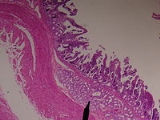
Brunner's glands
Encyclopedia
Brunner's glands are compound tubular submucosal
gland
s found in that portion of the duodenum
which is above the hepatopancreatic sphincter (Sphincter of Oddi). The main function of these glands is to produce a mucus-rich alkaline secretion (containing bicarbonate
) in order to:
They are the distinguishing feature of the duodenum, and are named for the Swiss
physician who first described them, Johann Conrad Brunner
.

Submucosa
In the gastrointestinal tract, the submucosa is the layer of dense irregular connective tissue or loose connective tissue that supports the mucosa, as well as joins the mucosa to the bulk of underlying smooth muscle .-Contents:Blood vessels, lymphatic vessels, and nerves will run through...
gland
Gland
A gland is an organ in an animal's body that synthesizes a substance for release of substances such as hormones or breast milk, often into the bloodstream or into cavities inside the body or its outer surface .- Types :...
s found in that portion of the duodenum
Duodenum
The duodenum is the first section of the small intestine in most higher vertebrates, including mammals, reptiles, and birds. In fish, the divisions of the small intestine are not as clear and the terms anterior intestine or proximal intestine may be used instead of duodenum...
which is above the hepatopancreatic sphincter (Sphincter of Oddi). The main function of these glands is to produce a mucus-rich alkaline secretion (containing bicarbonate
Bicarbonate
In inorganic chemistry, bicarbonate is an intermediate form in the deprotonation of carbonic acid...
) in order to:
- protect the duodenum from the acidic content of chymeChymeChyme is the semifluid mass of partly digested food expelled by the stomach into the duodenum.Also known as chymus, it is the liquid substance found in the stomach before passing through the pyloric valve and entering the duodenum...
(which is introduced into the duodenum from the stomachStomachThe stomach is a muscular, hollow, dilated part of the alimentary canal which functions as an important organ of the digestive tract in some animals, including vertebrates, echinoderms, insects , and molluscs. It is involved in the second phase of digestion, following mastication .The stomach is...
); - provide an alkaline condition for the intestinal enzymes to be active, thus enabling absorption to take place;
- lubricate the intestinal walls.
They are the distinguishing feature of the duodenum, and are named for the Swiss
Switzerland
Switzerland name of one of the Swiss cantons. ; ; ; or ), in its full name the Swiss Confederation , is a federal republic consisting of 26 cantons, with Bern as the seat of the federal authorities. The country is situated in Western Europe,Or Central Europe depending on the definition....
physician who first described them, Johann Conrad Brunner
Johann Conrad Brunner
Johann Conrad Brunner was a Swiss anatomist from Diessenhofen. He studied medicine in Schaffhausen, Strasbourg and Paris. At Schaffhausen he studied under Johann Jakob Wepfer , who was also his father-in-law...
.


